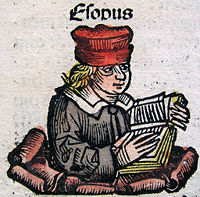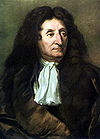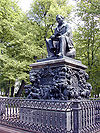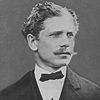Fable
- For other uses, see Fable (disambiguation).
A fable is a succinct story, in prose or verse, that employs the literary device, anthropomorphism - that is giving animals, plants, inanimate objects, or forces of nature, human attributes while expressing a simple moral or lesson. Examples abound in fables of talking animals that are whimsical, wise, or foolish creatures portraying our own human faults and foibles. A fable'smoral lesson, sometimes must be inferred, but at other times it is expressed at the end of the story with a pithy saying or maxim. Often times a fable will have a "twist" or a surprise at the end.
Fables, fairy tales, and parables all have in common the fact that they were handed down as an oral form of storytelling, sometimes recorded in writing much later than their time of actual creation. In such cases we might find traces of the historical record of traditions, beliefs and rites from bygone eras.
Fables, whether ancient or modern, have been used to satirize social and political institutions of their day. An examples of a modern day fable critiquing a social order (communism) would be George Orwell's Animal Farm; one critiquing modern social mores is Richard Bach's Jonathan Livingston Seagull; Hans Christian Andersen's satirization of royalty in the nineteenth century with The Emperor's New Clothes is another.
A fable though written as an easy to read child's story conveys a simple lesson that can be appreciated by person's of all ages. Fables, while being enjoyable and fun to read, can be an important part of a child's moral education.
Definitions
The word "fable" comes from the Latin "fabula" (a "story"), itself derived from "fari" ("to speak").
In a pejorative sense, a "fable" may be a deliberately invented or falsified account of an event or circumstance. Similarly, a non-authorial person who, wittingly or not, tells "tall tales," may be termed a "confabulator." In its original sense, however, "fable" denotes a brief, succinct story that is meant to impart a moral lesson.
An author of fables is termed a "fabulist," and the word "fabulous," strictly speaking, "pertains to a fable or fables." In recent decades, however, "fabulous" has come frequently to be used in the quite different meaning of "excellent" or "outstanding."
Characteristics
Fables can be described as a didactic mode of literature. That is, whether a fable has been handed down from generation to generation as oral literature, or constructed by a literary tale-teller, its purpose is to impart a lesson or value, or to give sage advice. Fables also provide opportunities to laugh at human folly, when they supply examples of behaviors to be avoided rather than emulated.
Fables frequently have as their central characters animals that are given anthropomorphic characteristics such as the ability to reason and speak. In antiquity, Aesop presented a wide range of animals as protagonists, including The Tortoise and the Hare which famously engage in a race against each other; and, in another classic fable, a fox which rejects grapes that are out of reach, as probably being sour ("sour grapes"). Medieval French fabliaux might feature Reynard the Fox, a trickster figure, and offer a subtext mildly subversive of the feudal social order. Similarly, the 18th-century Polish fabulist Ignacy Krasicki employs animals as the title actors in his striking verse fable, "The Lamb and the Wolves." Krasicki uses plants the same way in "The Violet and the Grass."
Personification may also be extended to things inanimate, as in Krasicki's "Bread and Sword." His "The Stream and the River," again, offers an example of personified forces of nature.
Divinities may also appear in fables as active agents. Aesop's Fables feature most of the Greek pantheon, including Zeus and Hermes.
Give example and synopsis of a fable in here somewhere.
History
The fable is one of the most enduring forms of folk literature, spread abroad, modern researchers agree,[1] less by literary anthologies than by oral transmission. Fables can be found in the literature of almost every country. The varying corpus denoted Aesopica or Aesop's Fables includes most of the best-known western fables, which are attributed to the legendary Aesop, supposed to have been a Greek slave around 550 B.C.E.
When Babrius set down fables from the Aesopica in verse for a Hellenistic Prince "Alexander," he expressly stated at the head of Book II that this type of "myth" that Aesop had introduced to the "sons of the Hellenes" had been an invention of "Syrians" from the time of "Ninos" (personifying Nineveh to Greeks) and Belos ("ruler").[2]
Several parallel animal fables in Sumerian and Akkadian are among those that E. Ebeling introduced to modern Western readers;[3] there are comparable fables from Egypt's Middle Kingdom,[4] and Hebrew fables such as the "king of trees" in Book of Judges 9 and "the thistle and the cedar tree" in II Kings 14:9.[5] Many other familiar ones include “The Crow and the Pitcher,” “The Hare and the Tortoise,” and “The Lion and the Mouse.”
Hundreds of fables were composed in ancient India during the first millennium B.C.E., often as stories within frame stories. These included Vishnu Sarma's Panchatantra, the Hitopadesha, Vikram and The Vampire, and Syntipas' Seven Wise Masters, which were collections of fables that were later influential throughout the Old World. Earlier Indian epics such as Vyasa's Mahabharata and Valmiki's Ramayana also contained fables within the main story, often as side stories or back-story. Some scholars have argued that these fables were influenced by similar Greek and Near Eastern ones.[6]
Epicharmus of Kos and Phormis are reported as having been among the first to invent comic fables.[7]
Fables had a further long tradition through the Middle Ages, and became part of European literature. During the 17th century, the French fabulist Jean de La Fontaine (1621-1695) saw the soul of the fable in the moral—a rule of behavior. Starting with the Aesopian pattern, La Fontaine set out to satirize the court, the church, the rising bourgeoisie, indeed the entire human scene of his time. La Fontaine's model was subsequently emulated by Poland's Ignacy Krasicki (1735-1801) and Russia's Ivan Krylov (1769-1844).
In modern times, the fable has been trivialized in children's books. Yet it has also been fully adapted to modern adult literature. For instance, James Thurber used the ancient style in his books, Fables for Our Time and The Beast in Me and Other Animals. George Orwell's Animal Farm satirizes Stalinist Communism in particular, and totalitarianism in general, in the guise of animal fable. Felix Salten's Bambi is a Bildungsroman—a story of a protagonist's coming-of-age—cast in the form of a fable.
Classic fabulists
- Aesop (mid-6th century B.C.E.), author of Aesop's Fables.
- Vishnu Sarma (ca. 200 B.C.E.), author of the anthropomorphic political treatise and fable collection, the Panchatantra.
- Bidpai (ca. 200 B.C.E.), author of Sanskrit (Hindu) and Pali (Buddhist) animal fables in verse and prose.
- Syntipas (ca. 100 B.C.E.), Indian philosopher, reputed author of a collection of tales known in Europe as The Story of the Seven Wise Masters.
- Gaius Julius Hyginus (Hyginus, Latin author, native of Spain or Alexandria, ca. 64 B.C.E. - 17 C.E.), author of Fabulae.
- Phaedrus (15 B.C.E. – 50 C.E.), Roman fabulist, by birth a Macedonian.
- Walter of England c.1175
- Marie de France (12th century).
- Berechiah ha-Nakdan (Berechiah the Punctuator, or Grammarian, 13th century), author of Jewish fables adapted from Aesop's Fables.
- Robert Henryson (Scottish, 15th century), author of The Morall Fabillis of Esope the Phrygian.
- Leonardo da Vinci (Italian, 1452 – 1519).
- Biernat of Lublin (Polish, 1465? – after 1529).
- Jean de La Fontaine (French, 1621 – 95).
- John Gay (English) (1685 – 1732)
- Ignacy Krasicki (Polish, 1735 – 1801).
- Dositej Obradović (Serbian, 1742? – 1811).
- Félix María de Samaniego (Spanish, 1745 – 1801), best known for "The Ant and the Cicade."
- Tomás de Iriarte (Spanish, 1750 – 91).
- Ivan Krylov (Russian, 1769 – 1844).
Modern fabulists
- Leo Tolstoy (1828 – 1910).
- Nico Maniquis (1834 – 1912).
- Ambrose Bierce (1842 – ?1914).
- Sholem Aleichem (1859 – 1916).
- George Ade (1866 – 1944), Fables in Slang, etc.
- Don Marquis (1878 – 1937), author of the fables of archy and mehitabel.
- Franz Kafka (1883 – 1924).
- Damon Runyon (1884 – 1946).
- James Thurber (1894 – 1961), Fables For Our Time.
- George Orwell (1903 – 50).
- Dr. Seuss (1904 – 91)
- Isaac Bashevis Singer (1904 – 91).
- José Saramago (born 1922).
- Italo Calvino (1923 – 85), "If on a winter's night a traveler," etc.
- Arnold Lobel (1933 – 87), author of Fables, winner 1981 Caldecott Medal.
- Ramsay Wood (born 1943), author of Kalila and Dimna: Fables of Friendship and Betrayal.
- Bill Willingham (born 1956), author of Fables graphic novels.
- Acrid Hermit (born 1962), author of http://www.createspace.com/3340070" Misty Forest Fables. isbn 9781605859309
Notable fables
- The Jataka Tales
- The Sky Is Falling
- Aesop's Fables by Aesop
- The Boy Who Cried Wolf
- Panchatantra by Vishnu Sarma (also known as Kalila and Dimna, Kalilag and Damnag, The Lights of Canopus, Fables of Bidpai, and The Morall Philosophie of Doni)
- Baital Pachisi (Vikram and The Vampire)
- Hitopadesha
- Seven Wise Masters by Syntipas
- Fables and Parables by Ignacy Krasicki
- Emperor's New Clothes
- Stone Soup
- The Little Engine that Could
- Jonathan Livingston Seagull
- Watership Down
- The Lion King
- The Fox and the Cock by James Thurber
- Animal Farm by George Orwell
See also
- Allegory
- Anthropomorphism
- Apologue
- Apologia
- Fairy tale
- Fantastique
- Ghost story
- Parable
- Proverb
Notes
- ↑ Enzyklopädie des Märchens (1977), see "Fabel," "Äsopica" etc. Retrieved July 5, 2008.
- ↑ Burkert 1992:121. Retrieved July 5, 2008.
- ↑ Ebeling, Die Babylonishe Fabel und ihre Bedeutung für die Literaturgeschichte (1931). Retrieved July 5, 2008.
- ↑ E. Brunner-Traut, Altägyptische Tiergeschichte und Fabel (1970). Retrieved July 5, 2008.
- ↑ Both noted by Walter Burkert, The Orientalizing Revolution: Near Eastern Influence on Early Archaic Greek Culture (1992), p 121 note 4. Retrieved July 5, 2008.
- ↑ Ben E. Perry, "Introduction," p. xix, in Babrius and Phaedrus (1965). Retrieved July 5, 2008.
- ↑ P.W. Buckham, p. 245. Retrieved July 5, 2008.
ReferencesISBN links support NWE through referral fees
- Buckham, Philip Wentworth [1827]. Theatre of the Greeks.
- King James Bible; New Testament (authorised).
External links
- Animal Symbolism. Raconter.net. Retrieved July 5, 2008.
- Bostrom, Nick. Journal of Medical Ethics. 2005. Vol. 31, No. 5, pp 273-277. The Fable of the Dragon-Tyrant. Nick Bostrom. Retrieved July 5, 2008.
- Fables - Collection and Guide to Fables for Children. Lefavole.org. Retrieved July 5, 2008.
- Home Page. Beast Fable Society. Retrieved July 5, 2008.
Credits
New World Encyclopedia writers and editors rewrote and completed the Wikipedia article in accordance with New World Encyclopedia standards. This article abides by terms of the Creative Commons CC-by-sa 3.0 License (CC-by-sa), which may be used and disseminated with proper attribution. Credit is due under the terms of this license that can reference both the New World Encyclopedia contributors and the selfless volunteer contributors of the Wikimedia Foundation. To cite this article click here for a list of acceptable citing formats.The history of earlier contributions by wikipedians is accessible to researchers here:
The history of this article since it was imported to New World Encyclopedia:
Note: Some restrictions may apply to use of individual images which are separately licensed.





